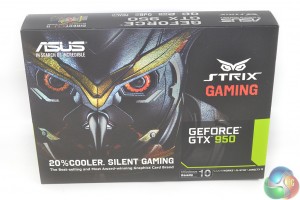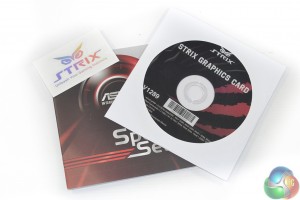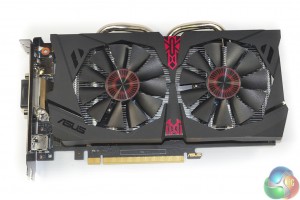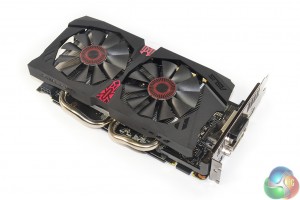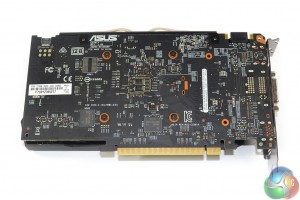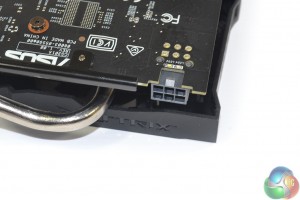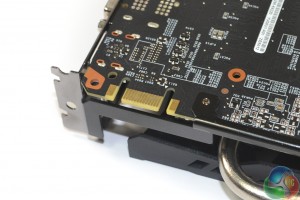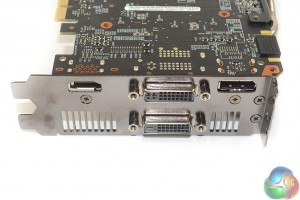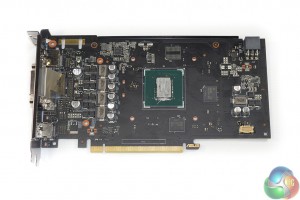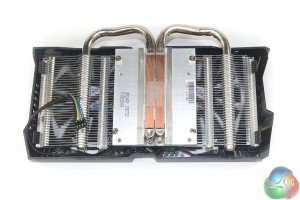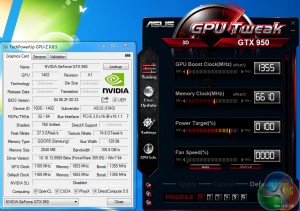Asus ships the STRIX Gaming GTX 950 DC2 OC in packaging featuring the owl branding. A drivers CD, manual, and sticker form the bundle.
The card measures in at 220mm due to a slight overhang by the DirectCU II cooler. The cooler is a dual-slot form factor and should fit comfortably inside many smaller mATX or gaming mITX cases. Red touches contrast the black plastic shroud.
As many of the latest Nvidia-based cards are able to do, Asus' STRIX GTX 950 can switch its fans completely off when the GPU core runs below a certain temperature. So when you are browsing the web or doing some light work, the cooler's fans enter their 0 dB mode. That is positive for users trying to build a quiet system that also has good cooling performance while gaming.
Asus builds the STRIX GTX 950 using the company's AUTO-EXTREME Technology, which is marketing speak for the automated manufacturing process. The matte black PCB will fit a system's colour-coded appearance well.
There is no backplate on Asus' card, although that is to be expected at this price point and when power circuitry cooling is not required.
With the GTX 950 reference card being rated for a 90W TDP, it comes as no surprise that we see a single 6-pin power connector. The GTX 750 and GTX 750 Ti did not use 6-pin power connectors, which made them ideal for HTPC usage or users who have a decent quality PSU but without the relevant PCIe power cable (I'm looking at you, Dell and HP users).
It seems that Nvidia settled on the 90W TDP and sacrificed the lack of power connector in order to situate the GTX 950 above the GTX 750 Ti in terms of performance. Despite requiring a PCIe cable, the power draw is unlikely to be a problem even for gamers with a relatively inexpensive PSU. Asus uses the power delivery headroom to overclock the GPU core frequency by a healthy margin.
A single SLI finger points at 2-way SLI support. A white or red LED placed above the power connector indicates whether the 6-pin cable is attached while the system has power.
Dual-link DVI-D, DVI-I, HDMI 2.0, and DisplayPort 1.2 are the video outputs. I am happy to see the inclusion of a DVI-I connection, as many budget gamers looking at this card may have a secondary monitor that uses an older VGA connection. HDMI 2.0 which is capable of a 4K resolution at 60Hz will be welcomed by HTPC users and those who may have a pair of 4K monitors. AMD's competitor does not support HDMI 2.0, which is a real concern for media enthusiasts with a 4K TV.
The GTX 950 GPU supports usage of four simultaneous display outputs.
The small PCB has a very clean look to it thanks to Asus' automated manufacturing process. A pair of 4Gb Samsung GDDR5 memory chips (marked K4G41325FC) are found on either side of the PCB to form the 2GB VRAM capacity. Asus clocks the card's memory 3MHz above the reference frequency of 1650MHz. Two unused spaces for memory chips are visible, so this implies that Asus is recycling its PCB design, or Nvidia has a slightly tweaked card in the works.
A 5-phase power delivery system (four for the GPU and one for memory/operation) consisting of Super Alloy Power II chokes, capacitors, and MOSFETs feeds the card. The chokes are touted to decrease buzzing thanks to their concrete materials, and I can confirm that coil whine was not an issue, at all, with my sample.
Asus smartly uses a metal brace which is leveraged against the expansion slot bracket in order to minimise PCB flex.
Two 8mm direct-touch copper heatpipes transfer thermal energy directly from the GPU to an aluminium fin array with a 1725.56cm2 dissipation area. The pair of fans, which we measured at 75mm blade-area diameter, feature Asus' patented pressure-enhancing design. According to Asus, its engineers have borrowed a few tricks from the aerospace industry in order to create 105% more air pressure from the wing-blade design.
The approach effectively uses a hump (which we would refer to as a camber when used on an aircraft wing/aerofoil) and a twist in order to drive air where the designers deem fit. An ability to drive the air to relevant areas of the surrounding zone allows the pressure differential to be optimised in an effective manner. Higher pressure, essentially, leads to greater heat transfer capacity of the fluid and therefore better temperature performance of the overall cooling system.
Asus ships the STRIX GTX 950 DC2 OC with a factory-overclocked setting applied. The core is rated to run at 1165MHz (141MHz greater than reference) with boosts up to 1355MHz (167MHz greater than reference), while memory is overclocked by a minor 10MHz to 6610MHz effective. We recorded the core boosting as high as 1392MHz over extended periods of gaming in our well-cooled system.
 KitGuru KitGuru.net – Tech News | Hardware News | Hardware Reviews | IOS | Mobile | Gaming | Graphics Cards
KitGuru KitGuru.net – Tech News | Hardware News | Hardware Reviews | IOS | Mobile | Gaming | Graphics Cards


